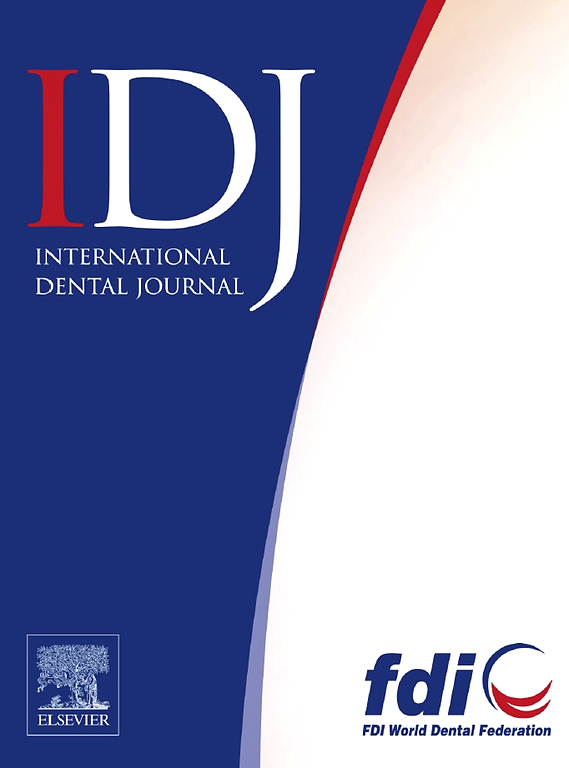牙齿发育阶段对儿童口面肌肉力量及口腔运动行为的影响
IF 3.7
3区 医学
Q1 DENTISTRY, ORAL SURGERY & MEDICINE
引用次数: 0
摘要
目的探讨不同牙期对健康儿童口腔面肌力量及咀嚼吞咽功能的影响。方法选取120例患儿,按照Hellman牙病分期标准分为原发性、早期混合型(IIC)、早期混合型(IIIA)、晚期混合型、早期恒型和晚期恒型6组。每一组都进行了一系列的测试,以测量他们的口面部肌肉力量和咀嚼和吞咽功能。数据分析采用单因素方差分析,随后进行Tukey事后检验,以调整连续牙期之间的多重比较。结果口腔面部肌肉力量逐渐增强,咀嚼和吞咽功能随牙期的发展而改善。具体而言,不同牙期之间的最大自主咬合力在初级牙期和早期混合牙期(IIC)、早期和晚期恒牙期之间、舌压在初级牙期和早期混合牙期(IIC)、早期混合牙期(IIIA)和晚期混合牙期之间存在显著差异。此外,在咀嚼和吞咽固体的测试中,初级和早期混合(IIC)牙期咀嚼循环次数和早期混合(IIIA)牙期和晚期混合牙期总进食时间存在显著差异。结论健康儿童口腔面肌力量随牙期发育逐渐改善。研究结果表明,牙期的提前对口腔面部肌肉力量的发展和咀嚼吞咽功能的改善起着重要的作用。这些发现提示了监测不同牙齿发育阶段儿童口腔运动行为发展的潜在意义。本研究中应用的一系列客观临床试验为评估口腔功能提供了一个有价值的临床框架。本文章由计算机程序翻译,如有差异,请以英文原文为准。
Influence of Dental Stages on Orofacial Muscle Strength and Oral Motor Behavior in Children
Aim
To study the effect of dental stages on orofacial muscle strength and masticatory and swallowing function in healthy children.
Methods
A total of 120 children were recruited and divided into 6 groups according to Hellman's criteria for dental stages: primary, early mixed (IIC), early mixed (IIIA), late mixed, early permanent and late permanent. Each group underwent a series of tests to measure their orofacial muscle strength and masticatory and swallowing function. The data was analysed using one-way ANOVA followed by Tukey’s post hoc tests to adjust for multiple comparisons between successive dental stages.
Results
The results of the study showed a gradual increase in orofacial muscle strength and improved masticatory and swallowing function with advancing dental stage. Specifically, significant differences between successive dental stages were shown in the maximum voluntary bite force between dental stages primary and early mixed (IIC), and between the early and late permanent, and in the tongue pressure between the primary and early mixed (IIC), and between the early mixed (IIIA) and late mixed. Additionally, in the test of masticating and swallowing solids, there were significant differences between dental stages primary and early mixed (IIC) in the number of chewing cycles, and between early (IIIA) and late mixed in the total eating duration.
Conclusion
Overall, there was a gradual improvement in orofacial muscle strength with more developed dental stages in healthy children. The results of the study imply that the advancement of dental stages plays an important role in the development of orofacial muscle strength and improved masticatory and swallowing functions.
Clinical Relevance
These findings suggest potential implications for monitoring the development of oral motor behaviours in growing children across different dental stages. The comprehensive battery of objective clinical tests applied in this study provides a valuable clinical framework for evaluating oral function.
求助全文
通过发布文献求助,成功后即可免费获取论文全文。
去求助
来源期刊

International dental journal
医学-牙科与口腔外科
CiteScore
4.80
自引率
6.10%
发文量
159
审稿时长
63 days
期刊介绍:
The International Dental Journal features peer-reviewed, scientific articles relevant to international oral health issues, as well as practical, informative articles aimed at clinicians.
 求助内容:
求助内容: 应助结果提醒方式:
应助结果提醒方式:


